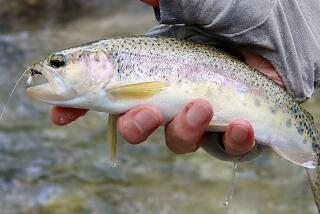Eradication Is a Tall Order as 25-Foot Weed Raises Cane
- Share via
Arundo donax is a weed that just won’t go away.
But that hasn’t deterred Ventura County conservationists from taking another whack at the 25-foot-tall reeds choking much of the Ventura River.
At the kickoff of an ambitious eradication project near Casitas Springs on Wednesday, officials said the hardy cane’s ability to replicate was a “cancer on the river.”
Over the next seven years, a consortium of government and environmental groups will spend $350,000 trying to figure out the best way to get rid of it. Money was contributed by several agencies, including the state Department of Fish and Game and the Southern California Steelhead Coalition
Arundo, which is native to Mediterranean countries, clogs rivers and crowds out native plants and shrubs, robbing animals of food and shelter, project supporters said. Fast-growing and thirsty, it sucks up water sorely needed for fish passage and human use, officials said.
By some estimates, arundo uses three times the water consumed by the native willows, mulefat and cottonwoods it is crowding out.
“We can’t afford to have arundo in our backyard,” said Russ Baggerly, a member of the Steelhead Coalition. “It removes precious water from our valley, and we’ve got to get rid of it.”
As officials spoke, four workers bent over a clump of the tall canes and began hacking them down. Huge piles of the hollow reed were whisked away to a composting machine, where they were chopped into tiny pieces.
The plan, directed by the Ventura County Resource Conservation District and the Watershed Protection District, is the latest attempt to take on the wily weed.
In 1996, arundo was Enemy No. 1 for another group of conservationists seeking to clean up and rejuvenate the mouth of the Ventura River.
Ventura County has guided other arundo eradication efforts at creeks and rivers in Simi Valley, Moorpark and Santa Paula, said Dennis Kanthack, who coordinates those efforts for the county.
This one will focus on different removal methods to determine which works best and is most cost-effective, Kanthack said.
In some areas, an herbicide will be applied to the canes after they have been chopped down. Conservation workers will also experiment with foliar sprays, while in other areas canes will be dug out clear to the roots, he said.
It will take about 30 days to clear the reeds from five acres, which will then be monitored for five to six years to determine which method worked best, Kanthack said.
That process will be used to get rid of another 250 acres of arundo found along the length of the river bottom, Kanthack said.
Officials chose a spot next to the popular Ojai Bike Trail for the demonstration project so passersby can see the work, Kanthack said.
“If you don’t get the public’s support,” he said, “you will never get this done on a wide scale.”
More to Read
Sign up for Essential California
The most important California stories and recommendations in your inbox every morning.
You may occasionally receive promotional content from the Los Angeles Times.











